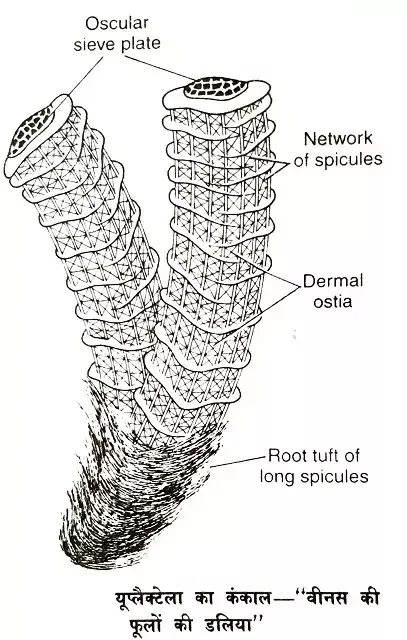Euplectella Overview
Classification of Euplectella:
Phylum: Porifera
Class: Hexactinellida
Order: Hexasterophore
Genus: Euplectella
 |
| Euplectella |
Habit and habitat:
Euplectella is a solitary animal found abundantly in deep waters at the depths of 500 to 5,000 meters in slow-running water, adapted for low water currents. Distribution: It is distributed near the Philippines and West Indies.
Comments of Euplectella:
(1) Commonly called Venus's flower basket due to its beautiful elegant glossy shape like a knitted elongated basket.
(2) The animal measures 15 to 30 cm in length and 2 to 5 cm in diameter.
(3) The body is long, rigidly curved, and cylindrical.
(4) The body is composed of four and six-rayed siliceous spicules interlaced and fused at their tips forming a three-dimensional network with parietal gaps.
(5) Spicules are joined together forming a network.
(6) The lower end contains usually a mass of long siliceous spicules in the form of a root tuft which fastens the animal with mud.
(7)The cloacal cavity is closed in above with a sieve plate.
(8) The osculum contains a sieve called an oscular sieve plate.
(9)The canal system is of simple Sycon type.
(10) Euplectella displays an interesting commensal relation with certain species of shrimps. A young female and male shrimp enter into spongocoel and after growth become unable to come out. Their entire life is passed in sponge prison. They feed on plankton in water current.
Special features of Euplectella:
Euplectella has great social and mythological value. The skeleton of this sponge, having imprisoned shrimps inside, is presented as a wedding gift to newly married couples in Japan, signifying close association. Identification: Since the specimen has a knitted basket-shaped body, Ostia, oscular sieve plate, and all the above features it is Euplectella.
Instructions:
Draw the specimen showing a cylindrical basket-shaped body, oscular sieve plate, parietal gaps, and root tuft.
Questions and their answers about Euplectella:
1. Introduction to Euplectella: The Glass Sponge
Commonly called Venus's flower basket due to its beautiful elegant glossy shape like a knitted elongated basket. The body is long, rigidly curved, and cylindrical. Euplectella displays an interesting commensal relationship with certain species of shrimps. A young female and male shrimp enter into spongocoel and after growth become unable to come out. Their entire life is passed in sponge prison. They feed on plankton in water current.
2. Taxonomy and Classification of Euplectella
The taxonomy and classification of Euplectella, commonly known as glass sponges, is a fascinating subject in the realm of marine biology. These remarkable creatures belong to the phylum Porifera and are characterized by their intricate, vase-like silica skeletons that resemble delicate glass sculptures. Within the Euplectella genus, there are several species, each with its own unique features and adaptations to deep-sea environments. Scientists study their morphology, genetic makeup, and ecological roles to better understand their evolutionary history and ecological significance. Through meticulous taxonomy and classification efforts, researchers aim to unravel the secrets of Euplectella's biology and its place in the complex web of marine life.
3. Morphology and Anatomy of Euplectella
In comments...
4. Habitat and Distribution of Euplectella Species
5. Reproduction and Life Cycle of Euplectella
The reproduction and life cycle of Euplectella, also known as the Venus' flower basket sponge, is a fascinating process in the underwater world. These unique sponges have a complex life cycle that involves both sexual and asexual reproduction. Euplectella sponges start as tiny larvae that swim freely in the ocean before settling on a substrate. Once settled, they undergo a transformation into the characteristic glassy, cylindrical structure that they are known for. Euplectella sponges reproduce sexually by releasing sperm and eggs into the water, where fertilization takes place. Asexual reproduction can also occur through the budding of new individuals from the parent sponge. This combination of sexual and asexual reproduction ensures the continuation of the Euplectella species and contributes to the marvel of their life cycle in the deep-sea ecosystem.
6. Euplectella's Unique Siliceous Skeleton
Euplectella, commonly known as the "Venus' flower basket," boasts a truly remarkable and unique siliceous skeleton. This deep-sea sponge, found in the oceans' abyssal depths, constructs an intricate lattice-like structure composed of glass-like silica spicules. This delicate, yet astonishingly strong framework not only provides Euplectella with its elegant, vase-like appearance but also serves as a testament to the wonders of nature's architectural ingenuity. Beyond its aesthetic appeal, Euplectella's siliceous skeleton showcases the extraordinary adaptability of marine lifeforms, perfectly suited to withstand the harsh conditions of the deep sea.
7. Ecological Significance of Euplectella in Deep-Sea Ecosystems
8. Euplectella as a Source of Inspiration for Biomimetic Materials
9. Threats and Conservation of Euplectella Species
The Euplectella species, commonly known as glass sponges, face several threats to their survival. Habitat destruction due to activities such as deep-sea mining and bottom trawling poses a significant danger to these delicate creatures, as they inhabit deep-sea environments. Additionally, climate change and ocean acidification can negatively impact the fragile ecosystems in which Euplectella species thrive. Conservation efforts are crucial to protect these unique organisms. Conservation strategies include the establishment of marine protected areas, responsible deep-sea exploration practices, and research to better understand their biology and ecological role. By addressing these threats and implementing conservation measures, we can hope to preserve the Euplectella species and the biodiversity of our oceans.
10. Scientific Research and Discoveries Involving Euplectella Sponges


No comments:
Post a Comment